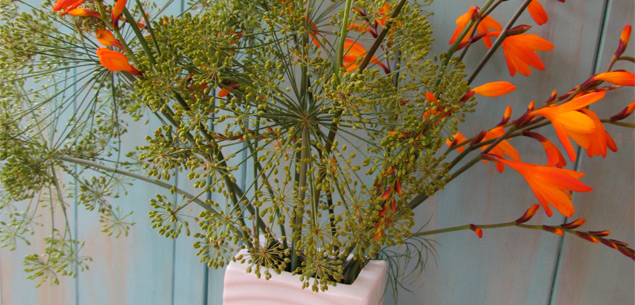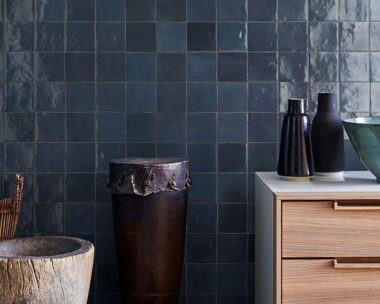When I was about 20, I lived in a cheerless flat in Dunedin and slept on a mattress on the floor – not because I couldn’t afford a bed, but because the mattress was considered rather bohemian and therefore very cool.
To offset the dreariness of it all, I would stick an arum lily in a milk bottle and sit it on the floor. Even cooler. Sadly, my flower-arranging talents have remained limited and it has fallen to my friend Annette to pick whatever is around the garden and turn it into a work of art for the living room.
Hard-pressed to find anything floral, she went foraging around the property and returned with handfuls of weeds and seeds to put together a delicious arrangement of montbretia and dill.

The invasive carrot weed is a bother in pastures, but it’s good company for a lonely agapanthus and a few sprigs of olive.
Considering dill is in competition with the cucumber to take over the world, I was pleased to find a use for it that didn’t involve eating fish every day. Furthermore, it had gone seriously to seed so the useful bits were few and far between.
Now, of course, I love the idea of weed arrangements (so sustainable) and have been foraging all over the immediate environs, scavenging neighbours’ gone-to-seed parsley and less savoury cast-offs. One of my favourites is montbretia. It is classified as a weed and appears on numerous regional council websites with admonishments about how naughty it is.
Nonetheless, I love seeing its cheerful orange flowers around the edge of the stream, and I’m fascinated by the variation in its colours. I waste quite a lot of time sorting the blooms into bright orange, apricot and yellow graduations and pairing them up with suitable foliage.
Montbretia is a garden hybrid of C. aurea and C. pottsii, two plants of the genus Crocosmia, and was first bred way back in 1880. It grows from perennial corms that are often spread in garden rubbish.

It doesn’t look like much in the paddock, but this purple top is gorgeous when teamed with a few seed heads and dry grasses.
At the risk of sounding like a contestant on MasterChef, I think it would
also work really well with gone-to-seed parsley. Then there’s carrot weed, or parsley dropwort. It’s an invasive pasture weed, especially in Northland, lowering the quality of the hay made from infested paddocks.
Animals won’t eat it, so it can become quite dominant in pastures once it flowers. I’m doing my bit by grabbing the flowers and teaming them up with olive-tree foliage and agapanthus. It needs a blast with hairspray to stop it from dropping bits on the windowsill.
Verbena bonariensis, or purple top, is a tall, slender-stemmed perennial with creeping rhizomes. It has vibrant purple flowers that appear from summer until autumn. You wouldn’t look twice at it on its own, but stuffed in a vase with a couple of seed heads and some dead foliage I combed out of the carex grass, it makes a rather stylish arrangement if I may say so myself.
Don’t get me wrong – I’m not recommending we cultivate weeds for floral arrangements or for any other reason. But if you’ve got weeds, you may as well get some use out of them.

More often than not seen as a hedge, abelias are gorgeous shrubs when left to grow naturally. Teamed up here with a silk tree, it’s a marriage made in heaven.
ABELIA
Type “abelia New Zealand” into Google and you’ll find there are hundreds, or possibly thousands, of motels with “abelia” in their name – as well as quite a number of women’s shoes. But you could be forgiven for thinking there was no such plant, at least in New Zealand.
However, real abelias are everywhere, and it’s fair to say they’re pretty much taken for granted. I‘m as guilty of that as anyone, having thrown a few straggly examples behind the wall of the carport to await the day I might feel enthusiastic enough to plant them.
In true abelia style, they planted themselves, grew speedily into a thick, glossy, free-form hedge, equally speedily produced masses of little flowers and quickly covered a piece of ground I’d been despairing of for months.
These wee treasures are native to Eastern Asia and southern North America. The species from warm climates are evergreen but in cooler climates they’re deciduous. They like heaps of sun (having said that, mine have thrived in almost total shade), protection from the wind and moist, well-drained soil. Given the right environment, they’re not much bothered by pests and diseases.
According to the UK Royal Horticultural Society website, which seems to be the only place in the world that acknowledges their existence, abelias may need hard pruning every three to four years. (I am yet to forgive The Partner for taking this to heart and whacking ours off at the halfway mark recently.)
Fortunately, they’re easy to propagate by softwood cuttings in early summer or semi-hardwood cuttings in late summer. What’s really great about abelias is their versatility. They make great hedges, they work as ground covers, they’re fantastic filler plants and they look just as good on their own.

SNOW SHOWERS
When we found out just what treasures abelias were, we went searching for other varieties and
discovered Abelia Snow Showers. It’s a variegated version that forms clumps, or buns, as our
nurseryman charmingly calls them. We bought three “buns”, which grew from the size of a saucer to the size of a Volkswagen in six months. They started flowering in early summer and are still covered in blooms. They will happily grow in semi-shade or sun and can withstand the cold.




